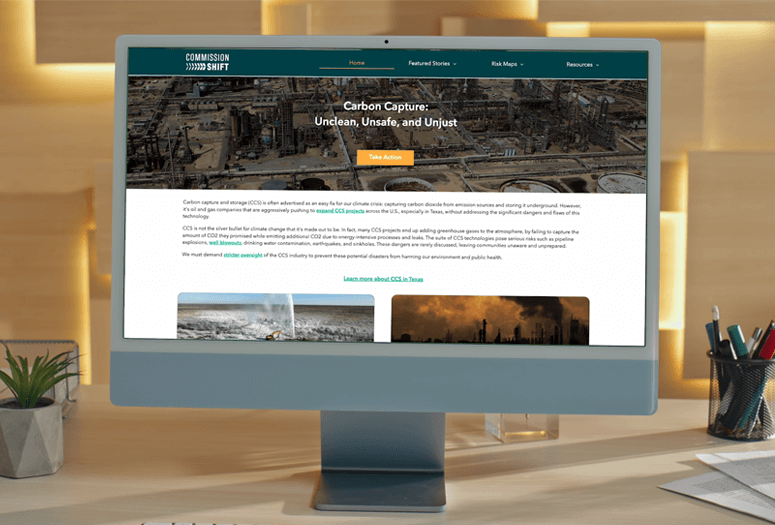Rice University students and faculty members collaborated with the nonprofit Commission Shift to create an interactive digital platform detailing the environmental impact of carbon capture and storage across Texas. The result is a website that functions like a digital museum exhibit, offering story maps, GIS map visualizations and advocacy tools to help communities understand and respond to potential environmental risks such as groundwater contamination, pipeline ruptures and increasing earthquake activities.
Carbon capture and storage involves capturing carbon dioxide emissions from industrial activities, transporting it and storing it deep within underground rock formations, preventing its release into the atmosphere and helping to mitigate climate change.
“We’re really grateful that we got to collaborate with Commission Shift this summer to work on this very amazing project,” said Rice junior Anya Yan, who joined juniors Paige Fastnow and Arryana Lyon on the project as part of the university’s Gulf Scholars Program (GSP).

Commission Shift focuses on reforming oil and gas oversight by holding the Railroad Commission of Texas accountable for its regulatory mission. Through this project in tandem with Commission Shift, Rice students helped develop a web-based educational tool that allows users to explore environmental risks through geospatial data and firsthand accounts.
“Our main function or value added to this project is to help them build a landing page and two story maps to really showcase the community aspects of the under-resourced communities in Texas that have been affected by the build-out of carbon capture and storage,” Yan said.
The project was a collaboration between several Rice entities, including GSP, the Center for Environmental Studies (CES), the Center for Civic Leadership and the Spatial Studies Lab in the Center of Research Computing, supported by the Diluvial Houston initiative. Students took the lead on crafting the story maps, while faculty members and specialists provided guidance and technical support.
“I have been working with the Gulf Scholars Program for a couple of years now, so I was aware of these kinds of research opportunities for students,” said Weston Twardowski, associate director of CES and the Rice Sustainability Institute’s EcoStudio. “In my role, one of my core responsibilities is maintaining a network of community partners who are environmental organizations and advocates throughout the state and the region. I play matchmaker, knowing their needs and understanding Rice student expertise, Rice faculty expertise and working together to formulate projects that can mutually benefit everyone.”
The students worked closely with the Spatial Studies Lab, which developed the interactive GIS maps and data visualizations for the project. The lab specializes in geospatial analytics and interactive mapping tools, making it an essential partner in translating complex data into accessible, visually engaging content.
“It’s a mix of multiple technologies,” said Uilvim Ettore Gardin Franco, a geospatial analytics and data visualization specialist at Rice’s Center for Research Computing. “We begin with the raw data. If the group is interested in specific locations or particular datasets, we collaborate with them to pinpoint where this data can be found. Next, we analyze the data to determine its suitability for upload to the web interface. Following this, we proceed to design a platform that integrates with the map. This involves utilizing a structure known as Experience Builder, which enables us to connect images, text and maps, creating an interactive experience.”
Over the course of several months, students, faculty and lab specialists worked together to turn raw environmental data into a structured, interactive experience.
The project also benefited from the mentorship of Stanislav Panin, a doctoral candidate in the Department of Religion, who helped keep the team organized and provided feedback on writing and communication strategies.
“The undergraduates did most of the work,” Panin said. “As a graduate mentor, I facilitated the team meetings, making sure that we were on schedule and that we had an agenda for every meeting.”

Panin helped guide the students through the writing process and on setting realistic milestones for the project.
For the students, one of the biggest lessons was learning how to make complex information more accessible to a broad audience.
“Through this kind of digital technology and interactive way of trying to consume information, you have to be really thoughtful through the process of how you translate very condensed knowledge into simpler language that most people can understand,” Yan said.
Twardowski emphasized the importance of ensuring the website effectively communicates its message to a diverse audience.
“One of the main goals I was working on was actually kind of brokering between the student questions such as, ‘Who is the audience for this?’ and working with Commission Shift to say, ‘This is a good question. Let’s think specifically,’” Twardowski said. “‘Let’s articulate a clear vision of what this digital communications platform needs to accomplish and for whom.’”
Accessibility was a key consideration throughout the project. While the website currently presents information in English, the team discussed expanding language options to make the content more inclusive for Texas’ diverse communities.
Beyond its educational function, the website includes an advocacy tool kit designed to help communities take action based on the information presented.
“We want to provide more resources to the people who are seeing this website that want to learn more,” Yan said. “You really need the communities’ engagement and power in order to achieve changes. I feel like you have to be really thoughtful of how to garner those powers together.”
For Franco, the highlight was seeing the platform in use.
“Sometimes our role places us in the middle ground between students and faculty, which means we don’t always witness the final outcomes of our efforts,” Franco said. “However, in this project, I was able to see some results already, and I’m eager to see even more.”

